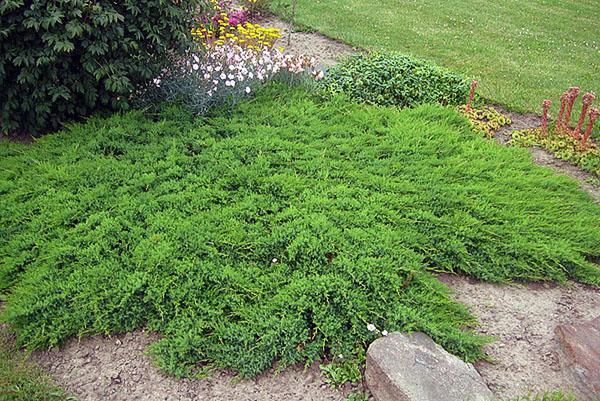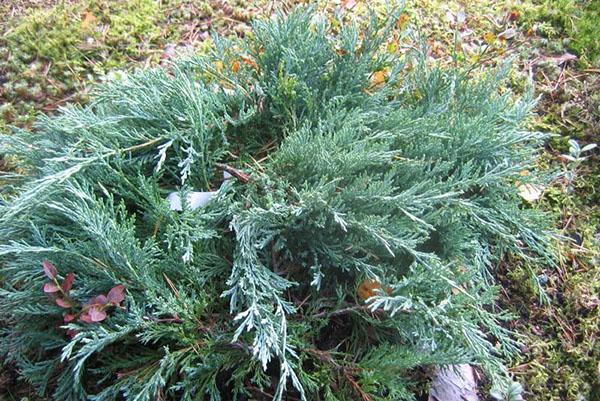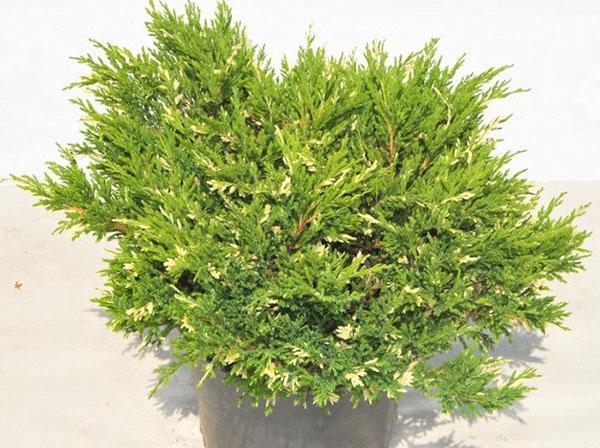Choosing a creeping juniper for our site
 The creeping juniper is one of the most valuable coniferous shrubs. Its main difference from other familiar juniper trees is its appearance. This species is often used as an ornamental plant because of the many varieties with various shades of needles, pleasant aroma and the ability to complement various compositions with them.
The creeping juniper is one of the most valuable coniferous shrubs. Its main difference from other familiar juniper trees is its appearance. This species is often used as an ornamental plant because of the many varieties with various shades of needles, pleasant aroma and the ability to complement various compositions with them.
External characteristics
The plant is a shrub that grows no more than 10 cm in height. Some types of creeping juniper reach 0.3-0.4 m in height and 2 m in width. Bush branches grow and spread along the ground. No foliage available. Depending on the variety, each branch is covered with short needles or light green scales.
The love of gardeners for the plant also lies in the fact that it likes the open sun, it is able to adapt to any soil without any problems, it can grow even in rocky places, it does not require moisture and does not lose its decorative appearance in the sun.
Varieties
About 60 varieties are known horizontal juniper... Externally, the plants are very similar to each other. Some creeping junipers are even grafted onto a low stem by gardeners. We present a photo of the most common varieties of creeping juniper:
- Agnieszka;

- Andorra Variegata;

- Bar Harbor;

- Douglasii;

- Gray Pearl;

- Hughes;

- Icee Blue;

- Limeglow;

- Plumosa;

- Prince of Wales;

- Andorra Compact;

- Blue Chip;

- blue forest creeping juniper;

- Golden Carpet;

- Wiltoni.

Planting creeping juniper
 Planting and leaving creeping juniper does not require much effort. For planting, take only young trees grown in containers.
Planting and leaving creeping juniper does not require much effort. For planting, take only young trees grown in containers.
When buying seedlings, it is advisable to choose those specimens that are sold with a clod of earth wrapped in burlap.
It is preferable to plant in the spring in April-May or wait until October. If you have purchased bushes with a clod of earth, planting can be done at any time, providing the plants with light shade and regular watering. An open place, illuminated by the sun, is selected for the shrub.
It is not recommended to plant the plant under the walls of buildings or in the shade, since it will lose its decorative effect, become sore, and the branches will lose their elasticity.
The soil is selected depending on the variety of creeping juniper. As a rule, the plant is undemanding to soil and grows well on calcareous, sandy soil, on loam. But some varieties require special growing conditions.
 It is advisable for planting to mix in equal proportions of coniferous soil, peat and sand. The depth of the hole should correspond to the 3 pins of the scapula in depth, observing the distance between the specimens of 1 m. Having lowered the seedlings into the hole and sprinkled with soil, it is necessary to water it directly under the root. Afterwards, mulching is performed near the trunk of a shrub, using coniferous wood chips for this purpose, peat.
It is advisable for planting to mix in equal proportions of coniferous soil, peat and sand. The depth of the hole should correspond to the 3 pins of the scapula in depth, observing the distance between the specimens of 1 m. Having lowered the seedlings into the hole and sprinkled with soil, it is necessary to water it directly under the root. Afterwards, mulching is performed near the trunk of a shrub, using coniferous wood chips for this purpose, peat.
Care rules
 Rooted creeping juniper is not difficult to care for. You just have to follow some rules. Juveniles should be watered regularly, but in moderation. Adult bushes are drought-resistant, so they should be watered 2-3 times a month. In extreme heat, in the early morning or at sunset, the bushes are irrigated.
Rooted creeping juniper is not difficult to care for. You just have to follow some rules. Juveniles should be watered regularly, but in moderation. Adult bushes are drought-resistant, so they should be watered 2-3 times a month. In extreme heat, in the early morning or at sunset, the bushes are irrigated.
With the onset of spring, plants are fed with nitroammophoska at the rate of 30-40 g of fertilizer per 1 m2 soil. Do not forget about weeding in the trunk circle. In order not to waste time on this constantly, you can spend mulching splinters, forest needles, gravel, laying them on black geotextile.
Juniper is affected by gray mold, mushroom rust. Eliminate them with special chemicals diluted according to the instructions on the package. With timely treatment, complete infection of the plant can be prevented.
To grow a healthy plant, the following rules must be followed:
- In winter, protect the branches from the severity of the snow by tying them up with twine.
- Cover the plant in heat.
- To avoid burning, the bushes need to be sprayed and watered.
- Spraying is carried out at a distance so that the juniper does not bend under the influence of water.
- With the onset of spring, prune diseased, dry and damaged branches.
- In the middle of summer, the juniper ostrich.
Reproduction
Juniper Is a dioecious plant. Reproduction of creeping juniper is carried out by layering (performed only during the growing season), seeds and cuttings. The first two methods are used very rarely, especially seed, since it lends itself only to professionals, because seedlings appear only 1-3 years after sowing. Therefore, the main breeding method is cuttings.
Cuttings can be cut from 8-year-old bushes at any time of the year, but preferably with the onset of spring.
The cut material (10 cm long) is first kept in wet burlap or water, after removing the needles from the bottom of the branch by about 5 cm, and then planted in the ground.
 Rooting is carried out in a greenhouse (including in winter) at a slight slope. After planting, the seedling is covered with plastic wrap and placed in a dark place. At the same time, the following requirements are observed:
Rooting is carried out in a greenhouse (including in winter) at a slight slope. After planting, the seedling is covered with plastic wrap and placed in a dark place. At the same time, the following requirements are observed:
- temperature 16-19º;
- diffused light;
- sufficient moisture in the substrate;
- regular spraying.
If the conditions are met, after 1-1.5 months, the cuttings will start up the first roots, after which, after waiting some more time, in the summer, the cuttings are transplanted together with a lump of earth into the open ground. Bushes are transplanted to a permanent place of residence only after 2-3 years.
 Fruiting of a creeping juniper occurs only after 2-3 years, with the formation of dark blue fruits on female bushes.
Fruiting of a creeping juniper occurs only after 2-3 years, with the formation of dark blue fruits on female bushes.
Compliance with all the rules will allow you to grow a healthy plant, which will certainly become the main focus of your garden.